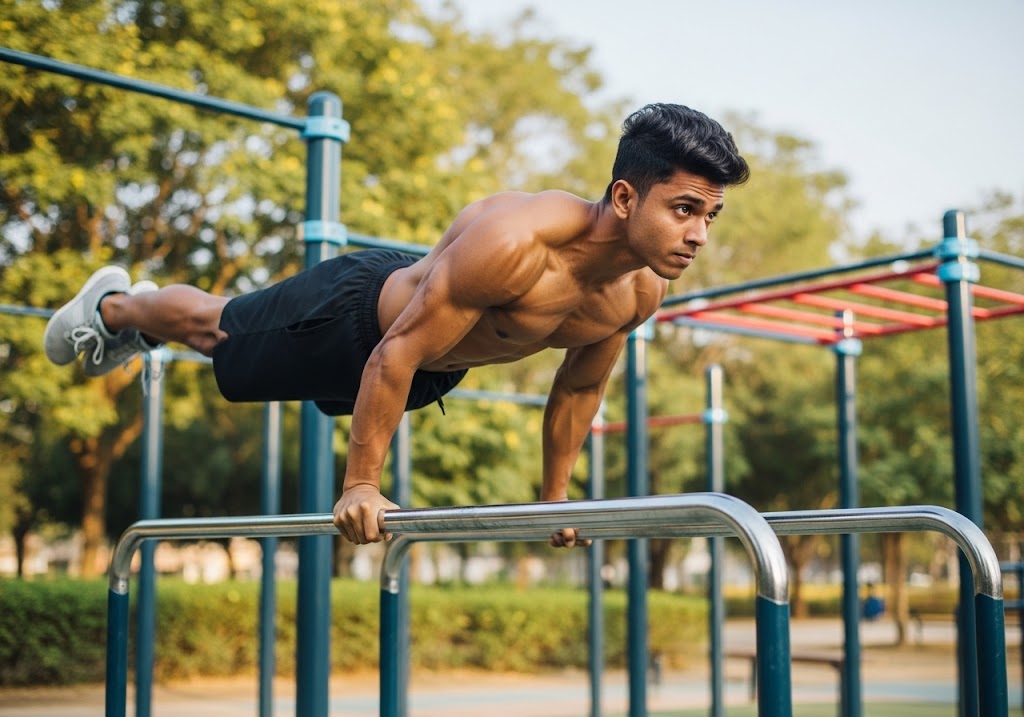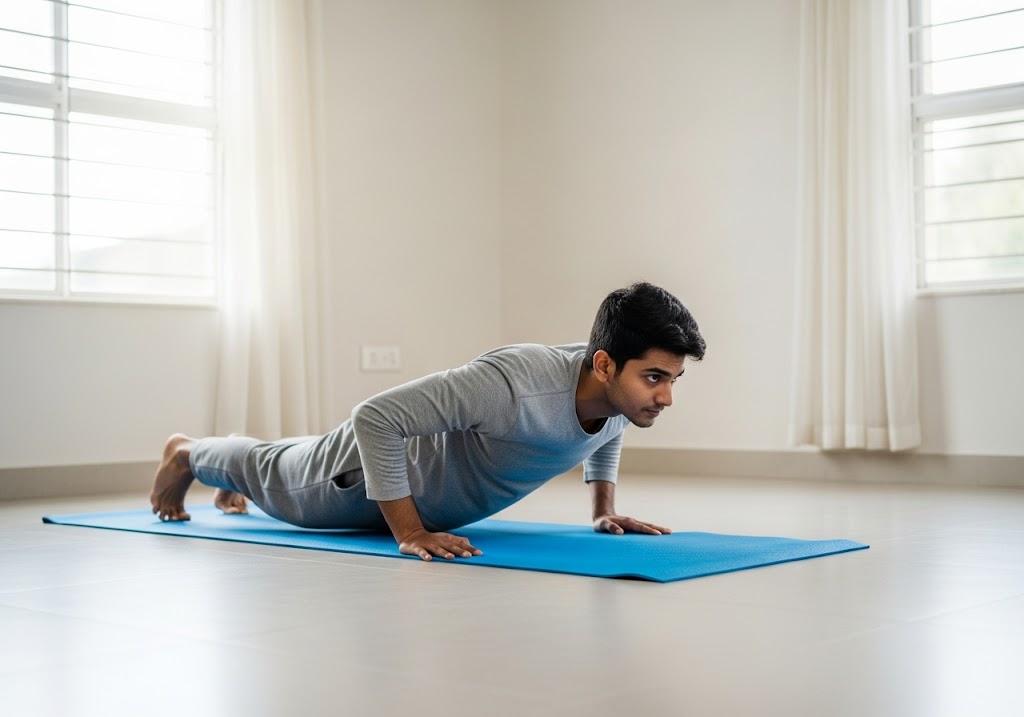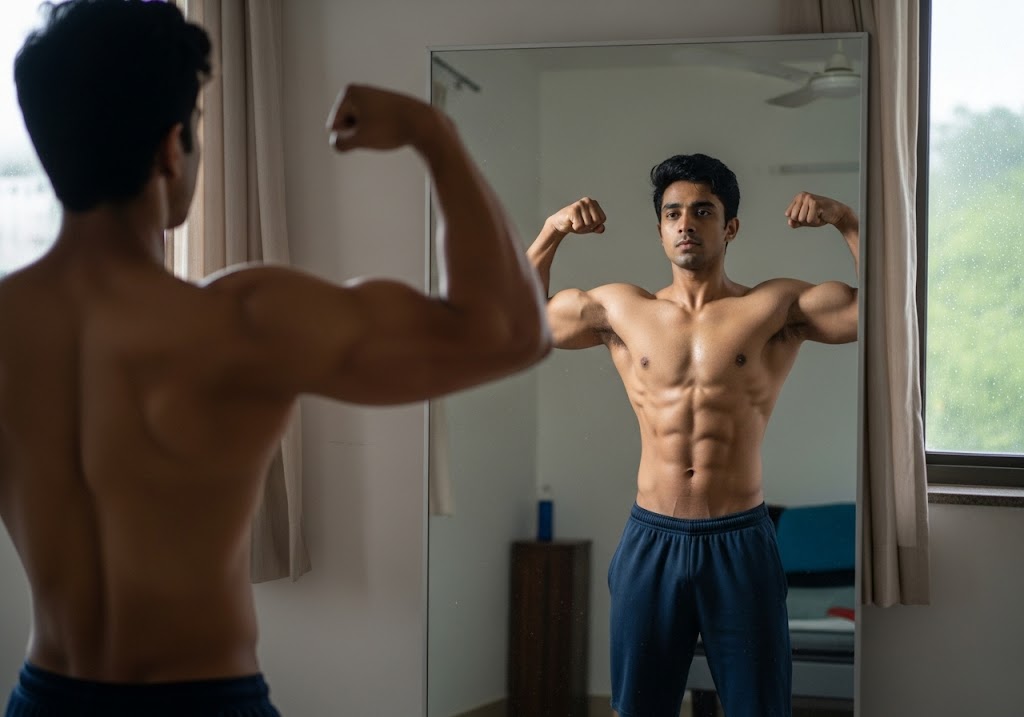Best exercises on how to burn 500 calories at home without equipment are: Burpees, Jumping Jacks, High Knees, Mountain Climbers, Squat Jumps, Push-ups, Plank Variations, Lunges, Dancing, Running in Place, Bear Crawls, Star Jumps, Bicycle Crunches, Jump Rope (imaginary), and Full-Body Circuits.
Want to know how to burn 500 calories at home without equipment using just your bodyweight? This complete fat-burning plan transforms your living room into a calorie-torching gym without expensive equipment or memberships required for effective weight loss results.
Table of Contents
Exercises That Burn the Most Calories at Home Using Calisthenics
These high-intensity calisthenics exercises maximize calorie burn through compound movements that work multiple muscle groups simultaneously. Each exercise targets different energy systems while maintaining elevated heart rate for optimal fat-burning results when learning how to burn 500 calories at home without equipment.
| Exercise | Calories/Minute (70kg person) | Primary Muscles | Intensity Level | Equipment Needed |
|---|---|---|---|---|
| Burpees | 12-15 | Full Body | Very High | None |
| Jumping Jacks | 8-12 | Full Body | High | None |
| Mountain Climbers | 10-14 | Core, Shoulders | High | None |
| High Knees | 8-12 | Legs, Core | High | None |
| Squat Jumps | 10-13 | Legs, Glutes | High | None |
| Push-ups | 7-10 | Upper Body | Moderate | None |
| Plank Hold | 5-8 | Core | Moderate | None |
| Lunges | 6-9 | Legs, Glutes | Moderate | None |
Understanding proper warm-up techniques before intense calorie-burning sessions is crucial, so exploring warm up exercises for beginners ensures safe and effective training preparation.
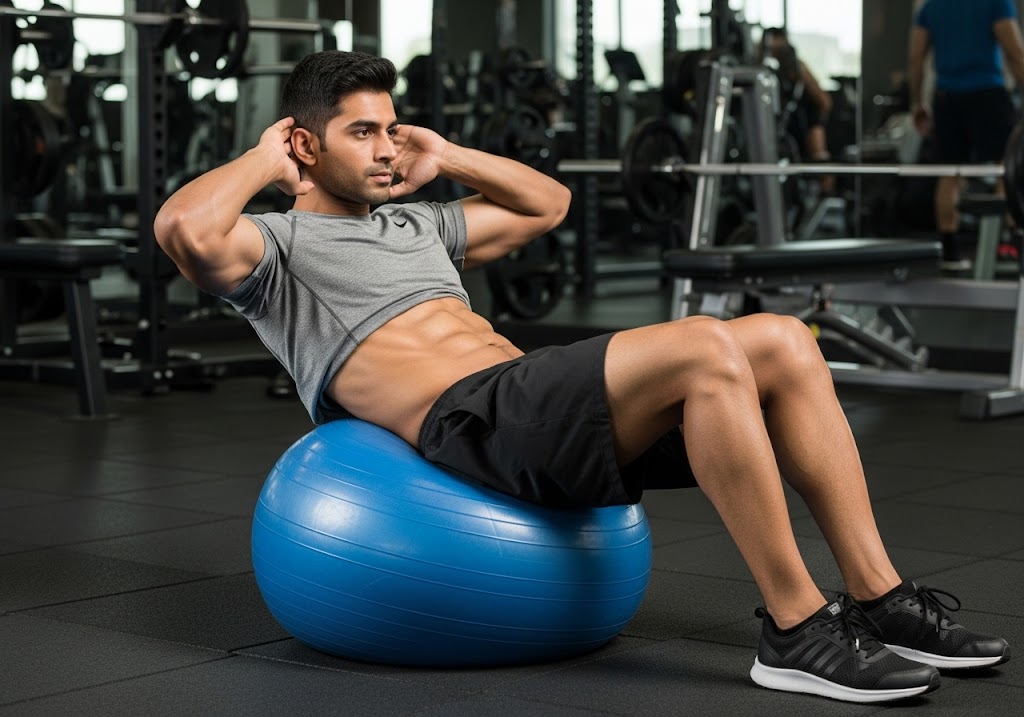
5 Weight Loss Exercises to Burn 500 Calories in 30 Minutes at Home
These five powerful exercises form the core of how to burn 500 calories at home fast when performed in high-intensity circuits. Each movement maximally challenges your cardiovascular system while building lean muscle for accelerated fat loss and improved metabolism.
1. Burpees – The Ultimate Calorie Burner
Burpees combine squat, plank, push-up, and jump movements into one explosive exercise that burns maximum calories. This full-body movement elevates heart rate rapidly while building strength and endurance simultaneously for superior fat-burning results.
- Perform 45 seconds of burpees followed by 15 seconds rest
- Complete 6-8 rounds for approximately 150-200 calories burned
- Focus on maintaining proper form throughout each repetition
- Modify by stepping back instead of jumping for beginners
- Advanced practitioners can add push-ups or tuck jumps
2. High-Intensity Jumping Jacks
Jumping jacks provide excellent cardiovascular conditioning while working your entire body through coordinated arm and leg movements. This classic exercise improves coordination while burning significant calories when performed at high intensity for extended periods.
- Jump feet apart while raising arms overhead simultaneously
- Return to starting position with feet together and arms at sides
- Perform continuously for 60 seconds followed by 15 seconds rest
- Complete 8-10 rounds for approximately 120-160 calories burned
- Maintain quick, rhythmic pace throughout entire exercise duration
For comprehensive information about this exercise’s benefits, jumping jacks exercise benefits provides detailed insights into muscle activation and calorie expenditure.
3. Mountain Climbers – Core and Cardio Combined
Mountain climbers effectively combine core strengthening with intense cardiovascular training through dynamic movement patterns. This exercise targets deep abdominal muscles while elevating heart rate for maximum calorie burn and improved core stability.
- Start in plank position with hands directly under shoulders
- Alternate bringing knees toward chest in running motion
- Maintain plank position throughout entire exercise duration
- Perform for 45 seconds followed by 15 seconds rest
- Complete 8-10 rounds for approximately 140-180 calories burned
4. Squat Jumps – Lower Body Power
Squat jumps build explosive leg power while burning significant calories through plyometric training principles. This exercise develops lower body strength and power while providing intense cardiovascular challenge for accelerated fat loss.
- Perform regular squat then explode upward into jump
- Land softly and immediately descend into next squat
- Keep chest up and knees aligned throughout movement
- Complete 30 seconds work followed by 30 seconds rest
- Perform 10-12 rounds for approximately 130-170 calories burned
5. Push-up Variations – Upper Body Strength
Push-up variations build upper body strength while contributing to overall calorie expenditure through sustained muscle activation. These exercises target chest, shoulders, and triceps while engaging core muscles for stability throughout each repetition.
- Perform standard, wide-grip, or diamond push-ups
- Complete as many repetitions as possible in 45 seconds
- Rest 15 seconds between sets
- Complete 6-8 rounds for approximately 80-120 calories burned
- Focus on full range of motion for maximum muscle activation
Understanding proper plank form that supports push-up technique, how to do plank exercise provides essential foundation training for upper body exercises.
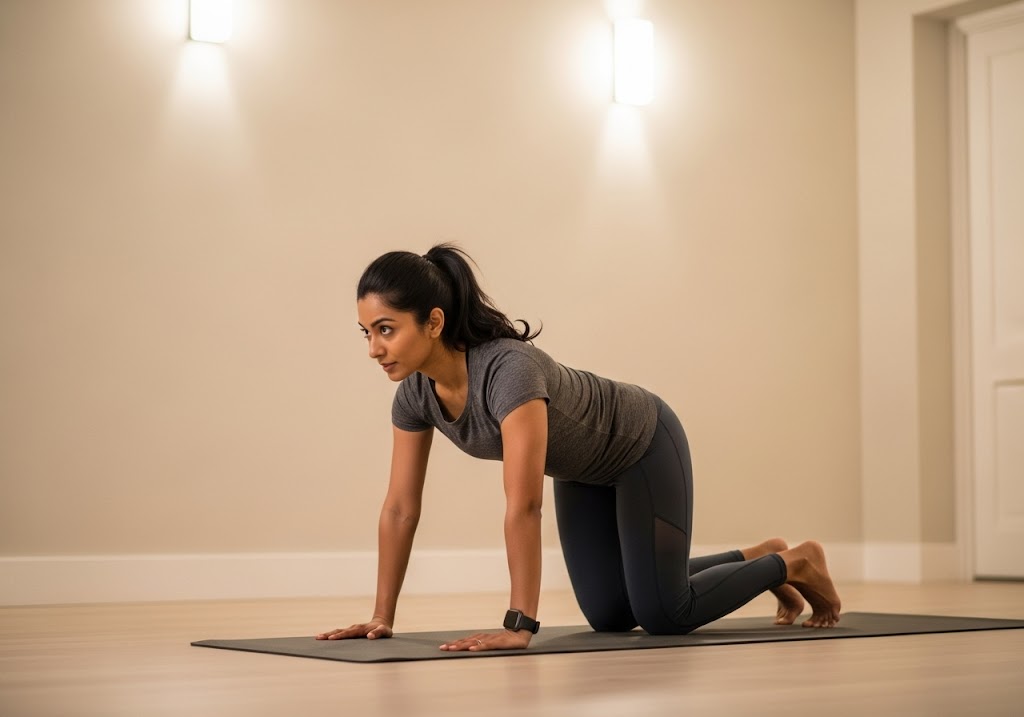
How to Burn 500 Calories?
Burning 500 calories requires strategic exercise selection and intensity management to maximize energy expenditure in minimum time. The key lies in combining high-intensity interval training with compound movements that work multiple muscle groups simultaneously while maintaining elevated heart rate throughout the entire workout session.
Circuit training proves most effective for how to burn 500 calories a day at home by alternating between different exercises with minimal rest periods. This approach maintains metabolic elevation while preventing muscle fatigue in any single area, allowing longer workout duration and greater total calorie expenditure than traditional single-exercise approaches.
How Long It Takes to Burn 500 Calories?
The duration required for how to burn 500 calories at home without equipment varies based on exercise intensity, body weight, and fitness level. Higher intensity exercises burn calories faster but may not be sustainable for extended periods.
| Body Weight | High Intensity (30 min) | Moderate Intensity (45 min) | Low Intensity (60 min) |
|---|---|---|---|
| 60kg | 480-520 calories | 450-500 calories | 400-450 calories |
| 70kg | 520-580 calories | 500-550 calories | 450-500 calories |
| 80kg | 580-640 calories | 550-600 calories | 500-550 calories |
| 90kg | 640-700 calories | 600-650 calories | 550-600 calories |
For beginners starting their fitness journey, bodyweight exercises for beginners provides excellent foundation movements before progressing to high-intensity calorie-burning routines.
Best HIIT Workouts for Maximum Calorie Burn
High-Intensity Interval Training maximizes calorie burn through alternating periods of maximum effort with brief recovery intervals. This training method creates significant afterburn effect, continuing to burn calories for hours after exercise completion.
20-Minute Calorie Crusher Circuit
This intense 20-minute circuit targets how to burn 500 calories at home fast through maximum effort intervals. Each exercise pushes your limits while providing brief recovery periods to maintain intensity throughout the entire session.
- 40 seconds work, 20 seconds rest for each exercise
- Complete 4 rounds of 5 exercises
- Rest 60 seconds between complete rounds
- Exercises: Burpees, Jump Squats, Mountain Climbers, Jumping Jacks, High Knees
Tabata Protocol for Fat Loss
Tabata training uses 20 seconds maximum effort followed by 10 seconds rest for ultimate intensity. This protocol burns significant calories while improving both aerobic and anaerobic fitness levels simultaneously.
- Choose 2-3 exercises for variety
- Perform 8 rounds (4 minutes) per exercise
- Rest 1 minute between different exercises
- Total workout time: 15-20 minutes
- Expected calorie burn: 200-300 calories
Learn how to burn 500 calories a day with effective workouts and smart habits that fit your lifestyle.
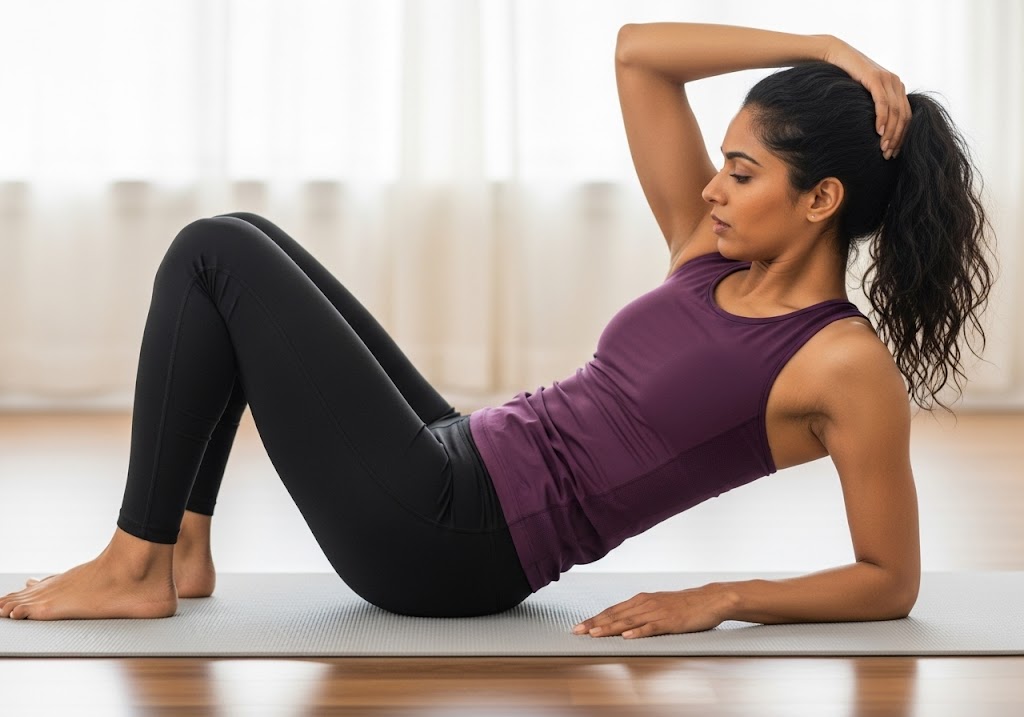
Bodyweight Strength Training for Calorie Burn
Strength training with bodyweight exercises builds lean muscle while burning calories during and after exercise. Muscle tissue requires energy for maintenance, increasing daily calorie expenditure even at rest for improved long-term weight management.
Upper Body Calorie Burners
Upper body exercises contribute significantly to total calorie expenditure while building functional strength. These movements target multiple muscle groups while maintaining elevated heart rate for combined strength and cardiovascular benefits.
Push-up variations form the foundation of upper body calorie burning through sustained muscle activation. Standard, wide-grip, diamond, and decline variations target different muscle groups while providing progressive difficulty levels for continued advancement.
Understanding push-up calorie expenditure, how many push ups to burn 100 calories provides specific targets for incorporating these exercises into calorie-burning routines.
Lower Body Power Movements
Lower body exercises burn the most calories due to large muscle group involvement and high energy demands. Squat variations, lunges, and plyometric movements create significant metabolic stress while building functional leg strength.
Jump squats, squat pulses, and single-leg squats provide progressive difficulty levels for continued calorie-burning advancement. These exercises develop power while maintaining high heart rate for optimal fat-burning conditions throughout extended workout sessions.
For understanding squat calorie expenditure, 100 squats burn how many calories provides specific targets for incorporating these fundamental movements.
Core Exercises That Burn Calories
Core exercises contribute to overall calorie burn while building abdominal strength and stability. While not the highest calorie burners individually, core exercises add valuable metabolic stress when combined with other movements in circuit training.
Dynamic Core Movements
Dynamic core exercises like bicycle crunches, Russian twists, and flutter kicks burn more calories than static holds. These movements engage multiple muscle groups while maintaining constant motion for elevated heart rate and energy expenditure.
Mountain climbers serve dual purpose as core strengtheners and calorie burners through sustained plank position with dynamic leg movement. This exercise challenges core stability while providing intense cardiovascular training for maximum efficiency.
For comprehensive core calorie information, how many calories can you burn doing crunches compares different abdominal exercises for calorie-burning effectiveness.
Plank Variations for Stability
Plank exercises build core endurance while contributing to overall calorie expenditure through sustained muscle activation. Various plank positions target different muscle groups while improving posture and spinal stability for long-term health benefits.
Side planks, plank ups, and walking planks increase difficulty while burning additional calories through increased muscle activation. These variations prevent adaptation while providing progressive challenges for continued improvement and calorie burning.
Understanding optimal plank frequency, how many planks should i do a day helps incorporate these exercises effectively into daily calorie-burning routines.
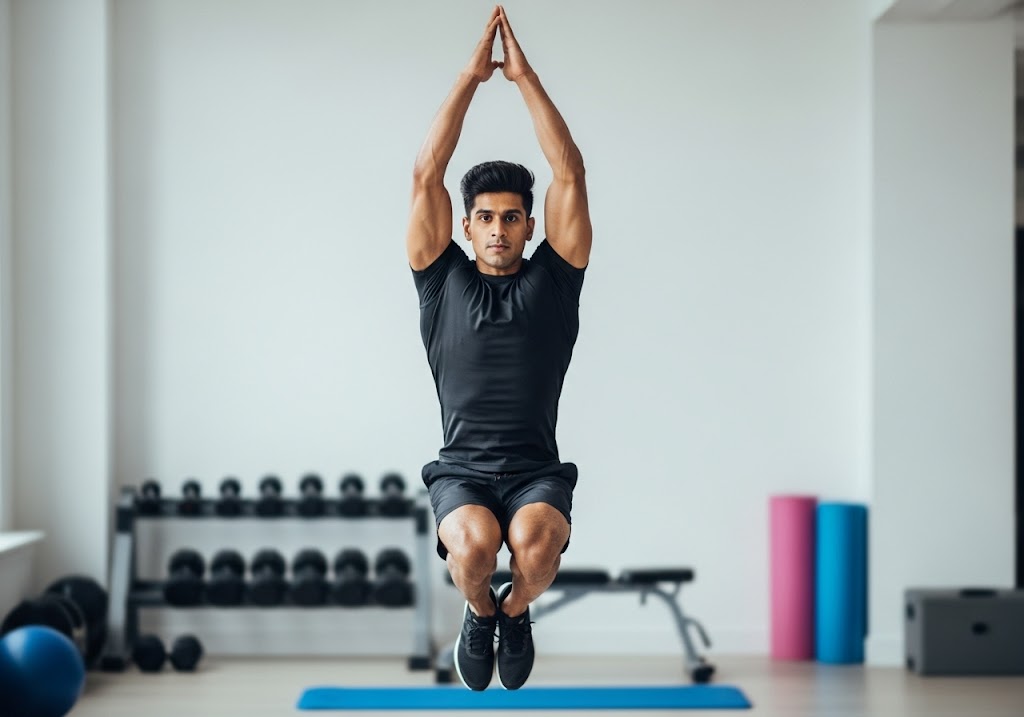
Creating Your Daily 500-Calorie Burn Plan
Developing a sustainable approach to how to burn 500 calories a day at home requires strategic planning and progressive implementation. Start with achievable goals and gradually increase intensity and duration as fitness improves over time.
| Week | Duration | Intensity | Focus | Expected Calories |
|---|---|---|---|---|
| 1-2 | 20-25 min | Moderate | Form learning | 300-400 |
| 3-4 | 25-30 min | Moderate-High | Endurance building | 400-450 |
| 5-6 | 30-35 min | High | Intensity focus | 450-500 |
| 7-8 | 35-40 min | High | Performance | 500+ |
Consistency proves more important than perfection when establishing daily calorie-burning habits. Aim for regular exercise sessions rather than sporadic intense workouts for sustainable weight loss and improved fitness levels over time.
Advanced Calorie-Burning Techniques
Advanced practitioners can maximize calorie burn through sophisticated training methods that push physiological limits. These techniques require solid fitness foundation and proper recovery protocols for safe implementation and optimal results.
Compound Movement Circuits
Compound exercises work multiple muscle groups simultaneously for maximum calorie expenditure per minute. These movements provide functional strength benefits while maintaining high energy demands throughout extended training sessions.
Burpee variations, squat-to-press combinations, and multi-directional lunges create complex movement patterns that challenge coordination while burning significant calories. These exercises improve athletic performance while accelerating fat loss through increased metabolic demand.
Plyometric Training Protocols
Plyometric exercises develop explosive power while burning calories through high-intensity muscle contractions. Jump training improves athletic performance while providing intense cardiovascular challenge for accelerated calorie expenditure and improved conditioning.
Jump squats, jump lunges, and broad jumps create significant metabolic stress while building power and speed. These exercises require proper landing mechanics and adequate recovery between sessions for injury prevention and optimal adaptation.
For advanced calisthenics progression, calisthenics planche provides challenging upper body exercises that significantly increase calorie burn through advanced bodyweight movements.
Nutrition Strategies to Support Calorie Burning
Proper nutrition supports intense calorie-burning workouts while optimizing recovery and adaptation. Strategic eating patterns enhance exercise performance while supporting the energy demands of how to burn 500 calories at home without equipment training.
Pre-workout nutrition should focus on easily digestible carbohydrates for immediate energy availability. Post-workout meals require protein and carbohydrates for recovery and adaptation support within the optimal recovery window for maximum training benefits.
| Timing | Macronutrient Focus | Purpose | Examples |
|---|---|---|---|
| Pre-workout | Carbohydrates | Energy | Banana, oats |
| Post-workout | Protein + Carbs | Recovery | Protein shake, rice |
| Daily | Balanced nutrition | Support | Whole foods |
Hydration becomes critical during intense calorie-burning sessions to maintain performance and prevent overheating. Adequate fluid intake before, during, and after exercise supports optimal physiological function and exercise capacity throughout demanding training sessions.
For comprehensive nutritional support, intermittent fasting plan provides structured eating approaches that complement high-intensity calorie-burning exercise programs.
Recovery and Adaptation Considerations
Proper recovery enables consistent high-intensity training necessary for daily 500-calorie burns. Recovery strategies include adequate sleep, stress management, and appropriate training frequency to prevent overuse injuries and maintain performance levels.
Sleep and Recovery
Quality sleep supports hormonal balance and recovery processes essential for sustained high-intensity training. Poor sleep impairs exercise performance and recovery while negatively affecting appetite regulation and metabolism for weight management goals.
Aim for 7-9 hours of quality sleep nightly to support intense calorie-burning exercise demands. Consistent sleep schedule and proper sleep hygiene practices optimize recovery and adaptation from demanding training sessions.
Understanding exercise timing considerations, is it better to do cardio before or after weights helps optimize training schedule for maximum calorie burn and recovery.
Managing Exercise-Related Soreness
Muscle soreness commonly occurs with intense calorie-burning exercise, especially when beginning new training programs. Understanding when to exercise through mild soreness versus when to rest prevents overuse injuries while maintaining training consistency.
Proper warm-up, cool-down, and recovery strategies minimize excessive soreness while supporting adaptation to increased training demands. Active recovery through light movement often proves more beneficial than complete rest for managing exercise-related muscle soreness.
For guidance on training with soreness, should you exercise with sore muscles provides evidence-based recommendations for safe training practices.
Tracking Progress and Motivation
Monitoring calorie burn progress provides motivation and enables program adjustments for continued advancement. Various tracking methods help quantify energy expenditure while identifying successful strategies for sustained weight loss and fitness improvement.
Heart rate monitoring provides real-time feedback on exercise intensity and estimated calorie expenditure. Wearable devices offer convenient tracking while smartphone apps provide workout guidance and progress monitoring for accountability and motivation.
Setting Realistic Goals
Establishing achievable targets prevents frustration while maintaining motivation for long-term success. Progress tracking should focus on consistency metrics rather than perfectionism for sustainable habit formation and continued advancement toward fitness goals.
Weekly calorie burn targets prove more manageable than daily perfection requirements. Aim for 3-4 successful sessions weekly rather than perfect daily adherence for realistic goal achievement and sustainable progress toward weight loss objectives.
Find out how much to run to burn 500 calories based on your pace, weight, and goals.
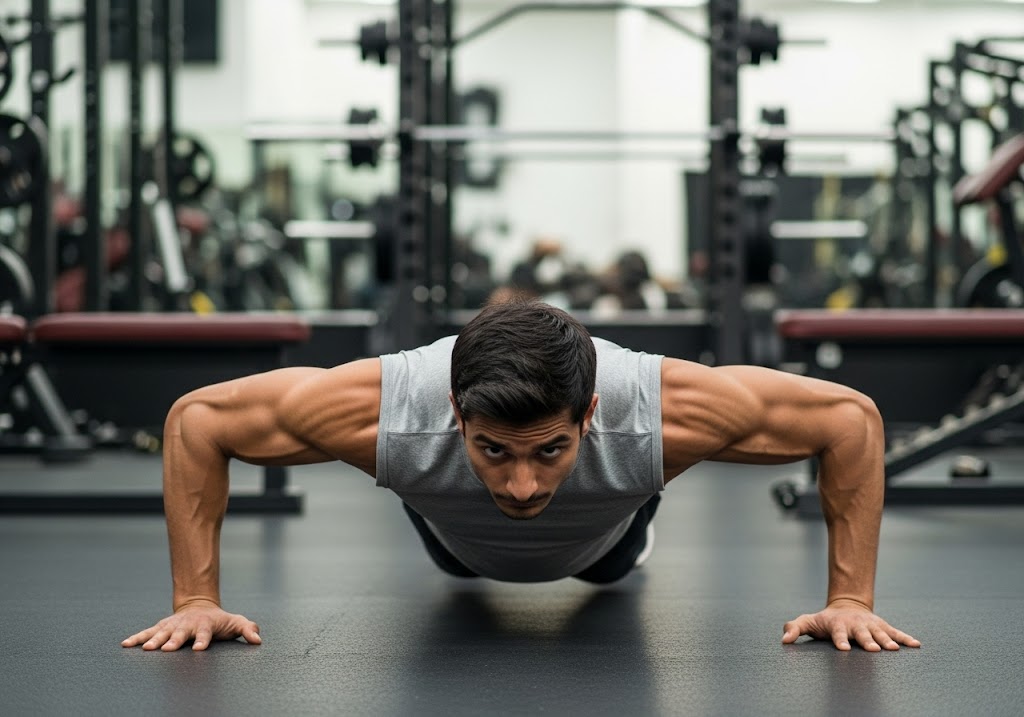
Safety Considerations for High-Intensity Training
High-intensity calorie-burning exercise requires attention to safety protocols for injury prevention. Proper progression, adequate recovery, and recognition of warning signs prevent overuse injuries while maintaining training consistency for optimal results.
Exercise progression should follow gradual intensity increases rather than dramatic jumps that exceed current fitness capacity. Listen to your body’s signals and adjust training intensity based on recovery status and performance indicators for safe advancement.
Recovery strategies including what is foam rolling help maintain muscle quality and reduce injury risk during intense training periods focused on high calorie expenditure.
Sample Weekly Workout Schedule
This structured approach to how to burn 500 calories at home without equipment ensures balanced training while allowing adequate recovery. Modify intensity based on current fitness level and gradually progress as conditioning improves over time.
| Day | Workout Type | Duration | Focus | Estimated Calories |
|---|---|---|---|---|
| Monday | HIIT Circuit | 35 min | Full body | 500+ |
| Tuesday | Moderate Cardio | 45 min | Endurance | 400-450 |
| Wednesday | Strength Circuit | 40 min | Muscle building | 450-500 |
| Thursday | Active Recovery | 20 min | Mobility | 100-150 |
| Friday | HIIT Circuit | 35 min | Intensity | 500+ |
| Saturday | Long Cardio | 60 min | Fat burning | 500-600 |
| Sunday | Rest | – | Complete recovery | – |
Flexibility in scheduling accommodates life demands while maintaining training consistency. Adjust workout days based on energy levels and time availability while preserving the overall training stimulus for continued calorie-burning progress.
For comprehensive bodyweight training programs, full body calisthenics workout provides structured routines that maximize calorie burn through compound movements.
Common Mistakes in Calorie-Burning Workouts
Avoiding common errors accelerates progress while preventing frustration and potential injuries. These mistakes often limit calorie burn effectiveness and may lead to training plateaus or overuse problems that interrupt consistent exercise participation.
- Starting Too Intensely: Beginning with maximum intensity before building fitness base leads to burnout and injury risk
- Ignoring Proper Form: Poor technique reduces exercise effectiveness while increasing injury potential significantly
- Inadequate Recovery: Insufficient rest between sessions prevents adaptation and increases overuse injury risk substantially
- Unrealistic Expectations: Expecting immediate results creates frustration and may lead to program abandonment prematurely
- Inconsistent Training: Sporadic exercise sessions prevent adaptation and limit long-term calorie-burning effectiveness
- Neglecting Nutrition: Poor dietary choices can negate calorie-burning efforts and limit weight loss progress significantly
Long-Term Sustainability Strategies
Creating sustainable habits for how to burn 500 calories at home without equipment requires strategic planning and realistic expectations. Focus on building consistent patterns rather than pursuing perfect execution for long-term success and maintained weight loss.
Variety in exercise selection prevents boredom while challenging different energy systems and movement patterns. Rotate between different workout styles and intensities to maintain engagement while providing comprehensive fitness development over time.
Progressive goal setting ensures continued advancement without overwhelming current capacity. Gradually increase workout duration, intensity, or frequency based on adaptation and performance improvements for sustainable progress toward long-term fitness objectives.
Understanding recovery techniques like cold shower vs hot shower can optimize post-workout recovery and adaptation for sustained high-intensity training.
Conclusion
Learning how to burn 500 calories at home without equipment transforms your living space into an effective fat-burning gym through strategic exercise selection and intensity management. These bodyweight movements provide comprehensive calorie-burning solutions that require no equipment while delivering substantial weight loss results. Whether you’re beginning your fitness journey or seeking convenient workout alternatives, how to burn 500 calories at home without equipment offers sustainable, effective strategies for achieving your weight loss goals through consistent, high-intensity bodyweight training that maximizes calorie expenditure and improves overall fitness levels.
Want to master the calisthenics handstand and take your skills to the next level? Whether you’re a beginner or pushing advanced skills, ISC – Indian School of Calisthenics offers expert guidance to help you master bodyweight training. Visit us at SRPF Ground, NH8, Goregaon (E), Mumbai – 400065. For class schedules, personalized coaching, or more details, call +91 77159 53218. Train smart, move better, and unlock your back strength with ISC.
How to Burn 500 Calories at Home Without Equipment? – FAQs
How to burn 500 calories without equipment?
Combine high-intensity exercises like burpees, jumping jacks, and mountain climbers in 30-40 minute circuit training sessions for effective equipment-free calorie burning.
Can I burn 500 calories in 30 minutes?
Yes, high-intensity bodyweight circuits including burpees, squat jumps, and running in place can burn 500 calories in 30 minutes for fit individuals.
How to burn 500 calories by walking?
Walking for 90-120 minutes at moderate pace (5-6 km/h) burns approximately 500 calories, depending on body weight and terrain difficulty.
How many steps burn 500 calories?
Approximately 10,000-12,000 steps burn 500 calories for average-weight individuals, though this varies based on pace, body weight, and individual metabolism.
How many calories are in 1 kg?
One kilogram of body fat contains approximately 7,700 calories, requiring a deficit of this amount to lose 1 kg of fat through diet and exercise.
Will walking 10k a day lose weight?
Yes, walking 10,000 steps daily burns 300-400 calories and can support weight loss when combined with proper nutrition and caloric deficit maintenance.
How to burn calories fast?
High-intensity interval training with burpees, jump squats, and mountain climbers burns calories fastest through maximum effort compound movements and elevated heart rate.
How many kms is 10,000 steps?
10,000 steps equals approximately 7-8 kilometers for average stride length, though this varies based on individual height and walking pace.
What exercise burns the most belly fat?
No exercise specifically burns belly fat, but high-intensity full-body exercises like burpees create caloric deficit necessary for overall fat loss including abdominal area.
How many jumping jacks to burn 500 calories?
Approximately 3,500-4,500 jumping jacks burn 500 calories, depending on body weight, intensity, and individual metabolic rate during exercise session.
How much do 30 minutes of exercise burn?
30 minutes of moderate exercise burns 200-300 calories, while high-intensity workouts can burn 400-500 calories depending on exercise type and individual factors.
